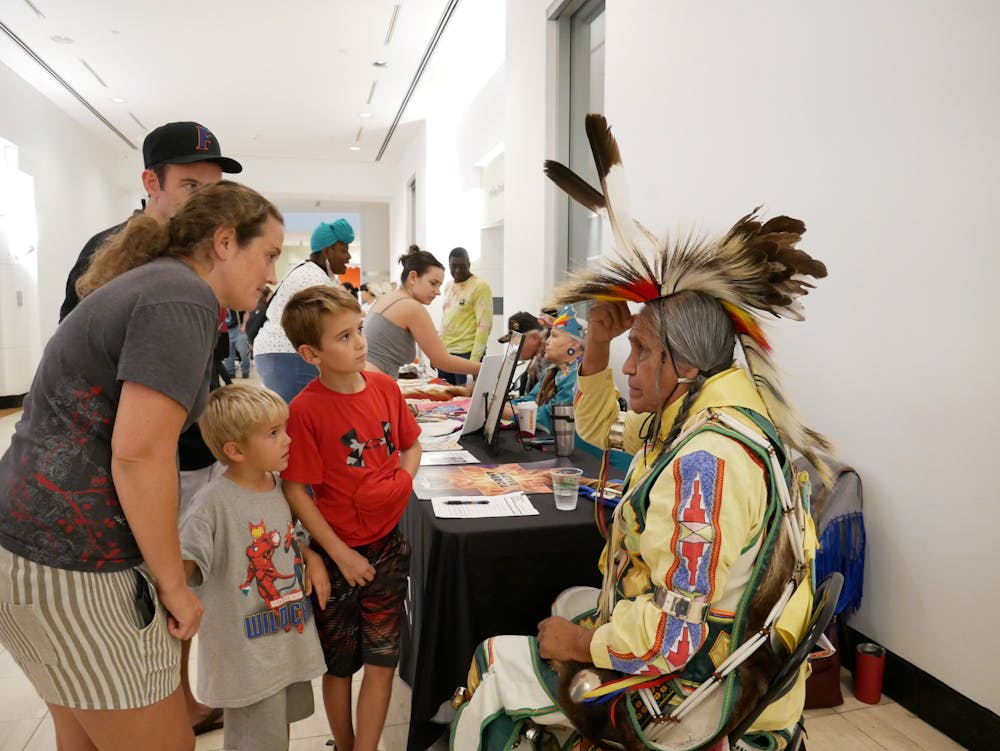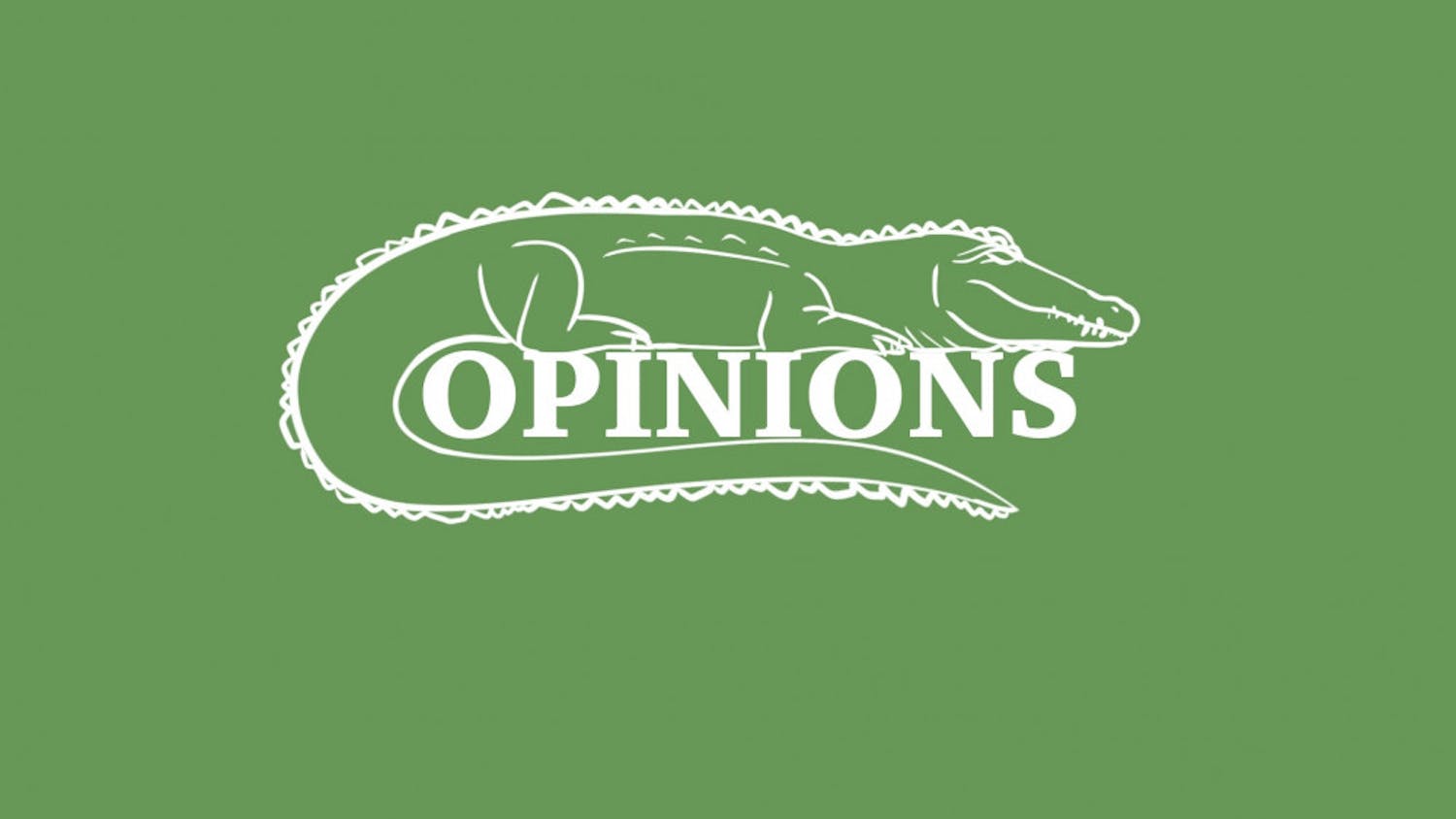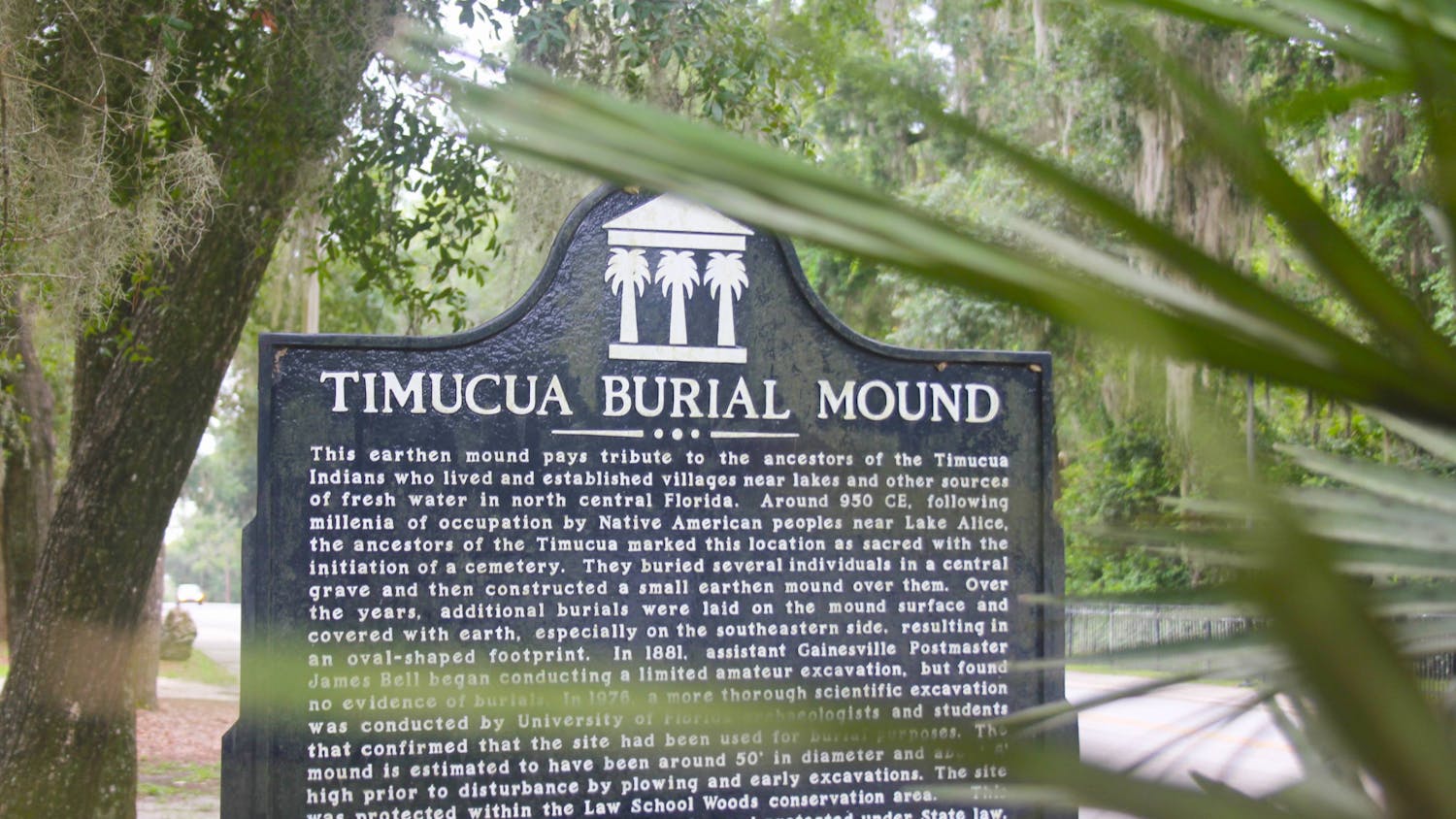The vibrant colors and sounds of the beaded jingle dresses and feathered headdresses and the beat of the drums gave a Harn Museum audience a dynamic show for all the senses. This was only the beginning of the festivities for the celebratory holiday of Indigenous Peoples’ Day at the Harn Museum of Art Thursday night.
Indigenous Peoples’ Day is a holiday that celebrates and raises awareness of the many cultures of Indigenous people. It acknowledges that Native people are the first inhabitants of the Americas and deserve to be recognized, represented and empowered.
Gainesville is the only city in Florida to change the name of the holiday from Columbus Day to Indigenous People’s Day in 2018, making Gainesville a huge hub for the community. While 574 tribes are federally recognized, there are several more nations across the country.
Generations of people enjoyed an array of activities and events, all curated to celebrate the rich cultures, histories and contributions of Indigenous People. Multiple tabling partners showcased community resources and information with the common mission of highlighting the beauty of Indigenous culture.
Many indigenous people gave museum-goers a taste of culture through different art expressions. From beaded clothing to clay pottery, each table presented a piece of different tribes from across two continents.
Duana Whitehorse, a 76-year-old from the Kiowa tribe of Oklahoma, makes unique clothing and moccasins for every occasion by hand. Using deer hide, feathers and colorful beads, each intricate piece takes days to create.
His wife, Maria Irizarry Whitehorse, a 73-year-old from the Taíno tribe in Borikén, modeled her husband’s handmade designs. Maria’s modest tea dress was designed to give women the ability to breastfeed children while they work on the fields and place them in the back when their child is done eating.
“It feels good to make our own [clothing] because we're proud of it,” Maria said.
The scheduled events for the night included two choreographed dances and a drum and dance demonstration with Maria Irizarry Whitehorse, Duana Whitehorse and Terrell Anquoe. Little bites and refreshments were offered all night long.
The performance was opened by the Indigenous Peoples Task Force who works to educate people about the existence and presence of indigenous people. One of their goals is to permanently change the name of the holiday everywhere.
The lively dance and drum performances are an outlet for storytelling. The dances, labeled incorrectly by many as war dances, are dances of prayers. Duana Whitehorse explained the motions of the dances and the differences in regional dancing traditions which differ from the clothes they wear to the style of dance. There are four different styles of women’s dancing and six different styles of men’s dances depending on age group.
Artists and friends Silvestre Hernandez-Reyes and Mario Mutis exhibited their handmade crafts alongside each other. Ten years ago, they started creating projects together and learning from each others’ crafts.
Hernandez-Reyes is a 46-year-old metalsmith and jewelry designer from the Comanche and Totonac tribes. He works to educate people about the jewelry making process and how to be proud of it. He incorporates symbols like the warrior jaguar, the frontier and the moon which is representative of the cycle of women into his pieces. Hernandez-Reyes sells his jewelry at local farmers markets and galleries.
Mutis, from the Muysca tribe, is a 34-year-old 3D arts professor at Santa Fe College. He creates functional hand-painted clay pottery with various uses including musical, spiritual, or educational. The pieces he creates are not for sale because they act as a form of expression and communication. He creates his art and gifts it to family and friends.
“My job in Santa Fe teaching feeds like my belly, right?” Mutis said. “And this stuff feeds like my spirit because I'm happy giving it to somebody.”
The metal casting technique he uses is a communal process done by Muysca people
that requires the breath of several people to reach the temperature required to create the clay pottery.
“Teaching that process is just as exciting as giving somebody a thing because you're transmitting knowledge,” Mutis said. “And you know that whatever happens to me, that knowledge stays alive.”
People are identifying as indigenous more than ever. The Native American population count more than doubled since 2000, despite being enumerated since the 1860 Census. Now, people are taking DNA tests and recognizing and identifying with their ancestry. Despite this, there are still large stigmas and misconceptions surrounding the Indigenous community.
“It's pretty bad because everybody's realizing that they can say yes [to their Indigenous identity] but my mom will not say she's indigenous,” Maria said. “Because she says they think we're savages.”
The first misconception people have about indigenous people is that they exist in the past context or do not exist at all anymore.
“A lot of people have their understanding and their relationship with those people is through media or movies, or books,” Mutis said. “We have to remember that we're still existing, we're still thriving. We're still struggling, but we still exist.”
Another misunderstanding is that Indigenous people are only native to the United States or Canada. Hernandez-Reyes’s family comes from North Mexico while Mutis’s ancestry is from the Cundiboyacense region of Colombia.
A massive common error people make is homogenizing Indigenous peoples’ identities and believing they are all the same and part of a one group. In reality, they have very different values, traditions, religions and practices. Maria and Duana Whitehorse have learned to compromise in many ways because of their different backgrounds and traditions. The Taino is a matriarchal tribe, while the Kiowa is patriarchal. Maria grew up on fish and vegetables while her husband eats deer and buffalo meat.
Despite all the differences between the tribes and nations, family and community is an essential value to everyone.
“We will fight back as hard as a man or harder because when it comes to defending your child or your family [you do] what you got to do,” Maria said.
There are many ways to learn more about each tribe. While the internet is a great resource for many, Hernandez-Reyes urges the importance of travel.
“You need to go into the deep of the land. That is when you really see the diversity,” Hernandez-Reyes said.
Indigenous Peoples’ Day is an important holiday in recognizing, appreciating and learning from the indigenous people and their rich histories.
“It [Indigenous People’s Day] means everything because we've been denied for so long. “Bringing it out now makes us proud that we're there, that we're doing something,” Maria said.
The Harn Museum MUSEs, volunteers of the Museum Undergraduate Student Educators, ran and organized a large portion of the event. It executed several activities and crafts in order to give museum-goers an interactive experience. In preparation for the museum night, the MUSEs visited the Florida Museum of Natural History’s exhibit on indigenous communities.
Another resource available to attendees were the docents. The volunteer museum educators gave brief art tours, a more approachable option of exploring the new exhibit. The four “Art Blast Tours” lasted about 15 minutes each and gave groups a snippet of what the collection has to offer. The tours explored the Florida Impressions Exhibition and the Modern Gallery.
This event was made possible by UF Student Government support whose funding gives students free memberships. The Harn’s Museum Nights occur every month and are free to the public.
Contact Molly Seghi at mseghi@alligator.org. Follow her on Twitter @molly_seghi.
Molly Seghi is a first-year journalism major at UF and a Fall 2023 Avenue Reporter. When not writing or journaling, she can be found at a live music event or working on her podcast “An Aural Account.”






